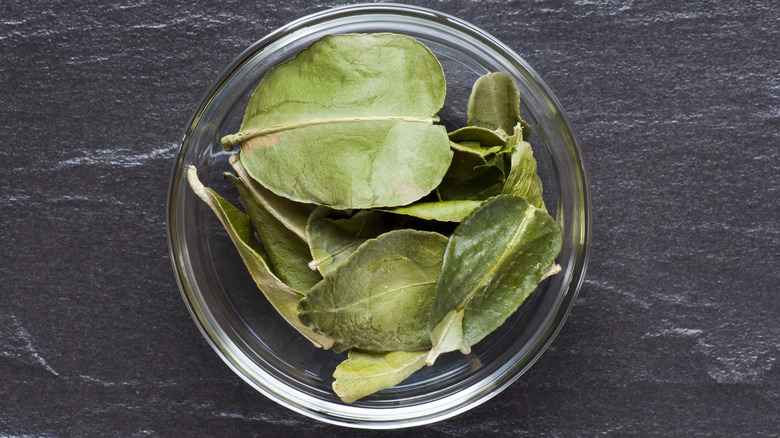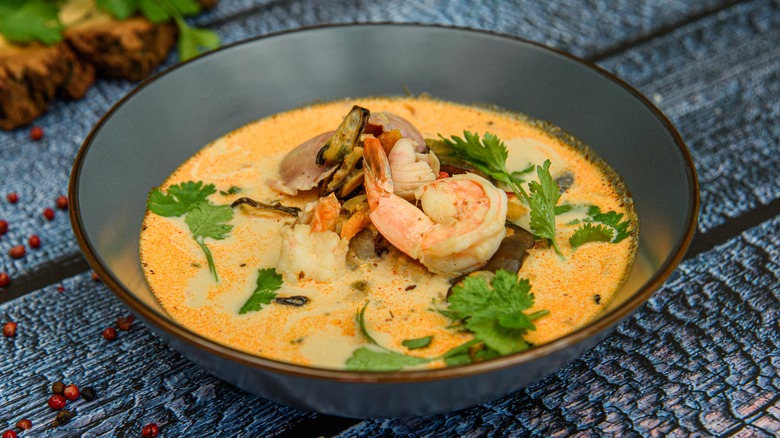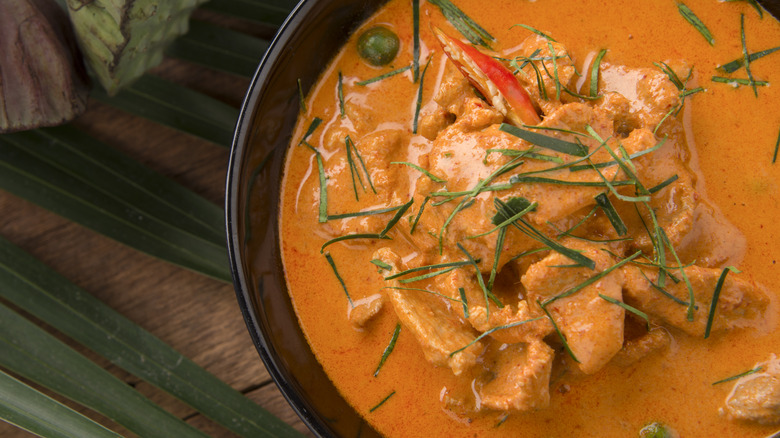How To Properly Use Makrut Lime Leaves In Your Next Soup
Smooth, shiny, and vividly shaded with a vibrant green hue, Makrut lime leaves are simply bursting with freshness. Also known as Kaffir leaves, Makrut lime leaves are traditionally used throughout Southeast Asian cooking, particularly in Vietnam, Thailand, Indonesia, and Malaysia. While these small leaves may resemble the peppery and bitter bay leaf, they are intrinsically more citrusy and floral, making them an excellent seasoning for soups.
Makrut leaves are available frozen, dried, or fresh. If using fresh leaves, they can be incorporated in a similar way to bay leaves, where they are left to imbue the dish with flavor before being removed and discarded before serving. They can also be finely sliced and mixed through the broth for a mega-flavor punch. However, the leaves are pretty tough, so the former method may be preferable to avoid a chewy bite.
Frozen leaves can be used immediately by simply placing them into the soup or thawed under hot water to revive some of the preserved flavors. Dried Makrut leaves can be rehydrated or ground. Although, like many spices, they may present a duller flavor profile than their fresh forms.
Which soups these leaves are best in
Some soups may demand a more robust Makrut lime leaf flavor, while others will simply flirt with the floral aromas. For instance, a creamy coconut pumpkin soup that needs brightening may incorporate a handful of fresh Makrut leaves into the broth while the pumpkin softens. They can then be removed before the soup is blended. If you want to experiment with a more intense citrusy flavor, you may wish to gently crush each leaf before adding it to the pot.
Naturally, the more leaves used in any soup, the more intense the flavor. For Thai recipes like Tom Yum soup or Tom Kha Gai, you may instead wish to keep the Makrut lime leaves inside for serving, similar to the lemongrass and other seasonings that are added; they remain in the broth as it's consumed.
For a punchy miso broth, the Makrut lime leaves can be crushed or chopped and simmered with warm ginger, citrusy lemongrass, pungent garlic, and a little chili. Once the soup has been imbued with all these glorious flavors, it can be strained so the tough pieces of leaf are removed. Using the Makrut leaves like this would accentuate their flavor, which works incredibly well when pairing it with a strong flavor like miso.
Other dishes to use Makrut lime leaves in
Soups are one thing, but other common uses for Makrut lime leaves in Asia may provide more inspiration for how these glorious leaves can be used. Panang Gai, a spicy and sour Thai chicken curry, uses shredded Makrut lime leaves to add a zesty punch to the sauce or extremely thin pieces as a garnish for color and freshness.
Makrut lime leaves can also be ground into a paste, as is the case with the incredibly delicious chargrilled chicken, which is popular in Vietnam. It's blended with garlic, chile, galangal, lemongrass, shallots, and spices to create a flavor-exploding marinade for the chicken.
These types of leaves can also be fried, as is the case with Cambodia roasted peanuts. They are shredded and added to a wok with peanuts, chili, lemongrass, and garlic. They take on this crispy texture that's gloriously sweet and lemony — blending well with the savory aroma of the nuts.
Ultimately, whether you use Makrut lime leaves in soups or other types of meals, they are exceptionally versatile. They're sure to open an aromatic gateway that will leave you going back for more.


